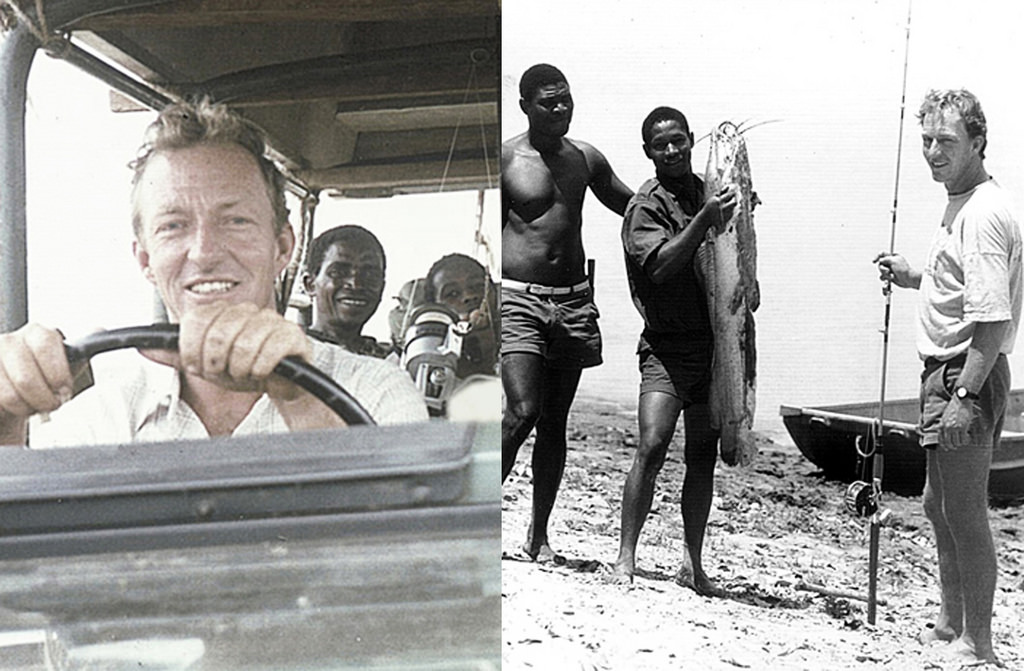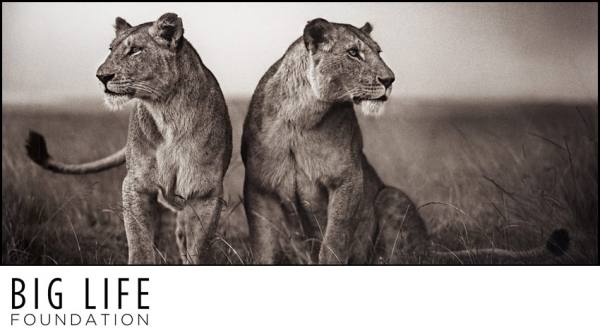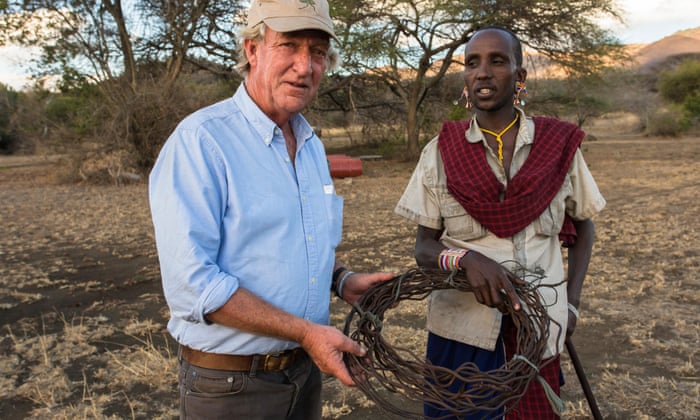Richard Bonham
A pioneer of community conservation in Kenya
(and founder of Sand River Selous in Tanzania)Richard Bonham
In the 1980s Richard Bonham leased 300,000 acres from the Maasai in the Chyulu Hills in south-west Kenya, beginning an almost three decades-long relationship with the local community. He understood early that sustainable conservation and tourism in Africa were possible only with the deep involvement of indigenous communities. (Today the ol Donyo Lodge offers guests an elite safari experience while providing jobs and profit-sharing to the Maasai.)
In 1992 he created the Maasailand Preservation Trust, working with the local people to improve education and health care, provide training in anti-poaching and habitat-conservation methods and establish a compensation fund for livestock killed by wildlife. In 2011 the trust was merged into Big Life Foundation, a non-profit started by Bonham and photographer Nick Brandt that has had a huge impact on the poaching crisis in the area.In 1994, following a contract to mount an expedition to the Selous GR in Tanzania, Bonham joined forces with Lizzy and Bimb Theobald, a British-Kenyan couple who lived in Dar es Salaam (and with a passion for conservation), establishing Sand Rivers safari lodge in the remote (and little-known) Selous Game Reserve in Tanzania - and later founded Nomad Tanzania with a group of other adventurous conservationists.
In 2014, Richard Bonham was awarded The Prince William Award for Conservation in Africa by the Duke of Cambridge at the Tusk Conservation Awards in London - an honour well deserved after a lifetime of committment to conservation.
Richard is the son of an early well known Kenyan Game Warden, Jack Bonham. This meant he had an early and vivid introduction to Wildlife, the bush and conservation. After a spell of bush flying in the Sudan, Zaire and East Africa Richard went into the safari business, concentrating in walking safaris in the remoter and wilder parts of East Africa.
In the mid-80's, Richard negotiated a 300,000 acre concession on a Maasai-owned ranch, Mbirikani Group Ranch, where he still currently lives. This ranch forms an integral part of the Amboseli ecosystem. It became clear to Richard from the outset that the only way that the Wildlife and the habitat of the area could be sustained was to partner and involve the local community themselves, through economic incentive-based conservation enterprises, employment and participating in law enforcement themselves. Richard pioneered the Community Game Scout concept in the late 80's by employing four local Maasai warriors to collect snares which were appearing in growing quantities, 20 years later this the project has expanded to employing and training over 100 game scouts from the local community and operating over most of the ecosystem. In 2009 alone, working closely with Kenya Wildlife Service, these dedicated scouts prosecuted over 500 poachers and illegal loggers. (This number could and should be doubled with better resources and logistical support. These scouts also double as general security for the area, protecting farms from crop raiding wildlife, following up stock theft and crime so providing an appreciated service to the community.)The Maaasailand Preservation Trust
Richard's conservation history is not limited to the law enforcement approach, The Maaasailand Preservation Trust which he started has played an integral part in setting up health clinics, schools and a Wildlife scholarship program that has put hundreds of students through school. The Maasailand Preservation Trust also pioneered the a Predator Compensation project that now covers over 700.000 acres of the ecosystem, This economic incentive based approach is attempting to turn the tide of looming local extinction of predators. These predators, especially lion, are being killed in retaliation for their killing of livestock, on which the local community depend upon for their livelihood. Rhino have also figured in Richard’s conservation history. In the mid 90's he was a key player in setting up the Selous Rhino Trust, and at home in the Chyulus, his scouts, together with KWS, are working around the clock to preserve what is probably the last unmanaged Black Rhino populations in Africa.Courtesy: Big Life Foundation.
ABOUT BIG LIFE FOUNDATION
Big Life Foundation was founded in 2010 by photographer Nick Brandt and award-winning conservationist Richard Bonham to address the dramatic escalation in poaching in East Africa. Today, Big Life protects upwards of 2 million acres in the Amboseli-Tsavo-Kilimanjaro ecosystem that straddles Kenya and Tanzania. They employ hundreds of fully equipped rangers in dozens of outposts across the region, including mobile units, tracker dogs, aerial surveillance, and a vast network of informants.
As a result, Big Life has dramatically reduced poaching in the region. Their ranger teams have facilitated over 2,000 arrests, including some of the most prolific and long-term poachers in the region. Their success sends a strong message that killing wildlife carries swift and serious punishment.Tusk Conservation Award 2014
Tusk has been working since 1990 to build a sustainable future for the people and the wildlife of the African continent. These annual awards, presented by Prince William, highlight inspirational conservation work in Africa, ranging from the protection of endangered species and threatened habitat to the promotion of environmental education and the development of community driven conservation (tuskawards.com).
Our congratulations to Richard have no limits in reflecting our pride and support of this great man’s dedication to conservation. It is gratifying for all conservationists to see recognition being given to someone who works tirelessly for the cause; walking, flying, managing patrols and negotiating daily for the preservation of important wildlife in and around the ol Donyo area and Maasailand in general. Kenya shines under the spotlight when it shares the stage with Richard and in this case the Duke of Cambridge. I know that Richard values the award and the reward of seeing lions and leopards coming back to the area, and large tusker elephants under protection, as much. - Dereck Joubert, National Geographic Explorer-in-Residence and CEO of Great Plains Conservation following his Tusk Conservation Award.
This is no small feat. The lifetime achievement award reflects the individual’s outstanding personal commitment and contribution to conservation efforts in Africa. In the case of Bonham, this includes founding the Maasailand Preservation Trust recently merged with Big Life (www.biglife.org) and headquartered at Great Plains Conservation’s award-winning ol Donyo Lodge. Bonham’s commitment to innovative community conservation techniques such as the Predator Compensation Scheme and Maasai Olympics has resulted in reduced conflict between Maasai and predators and increased regional lion populations throughout the region. His team provides invaluable anti-poaching support in the region as the ‘boots on the ground’ force. Further, his leadership improved rural livelihoods through education, employment and tourism ventures with ol Donyo Lodge.
Courtesy: Great Plains Conservation
ARTICLES OF INTEREST
Selous by any other name: Nomad Tanzania Blog -December 2020
One man's fight against Africa's ivory poachers - John Vidal, The Guardian 2014
Tanzania: Home to the world's wildest game reserve by Tira Shubart with The Telegraph 2000
PUBLICATIONS OF INTEREST
Wild Heart of Africa by Rolf Baldus 2009 - ISBN 10: 0980262682 / ISBN 13: 9780980262681
The Selous, a game reserve in southern Tanzania, is the largest protected wildlife area in the world. There are no people living within its boundaries and it contains some of the greatest wildlife concentrations on the continent, including 70 000 elephant, over 120 000 buffalo, more than half a million antelope and a couple of thousand large carnivores roaming freely in its forests, riverine thickets, steppes and mountain ranges. The contributors to this book share over a century of work in the reserve. They also share the belief that the Selous is not only the largest and oldest protected area in Africa but that it is also one of the finest in the world. They hope that this book will make the public aware of how important it is to conserve this World Heritage Site.
Go back to: Pioneers in conservation



